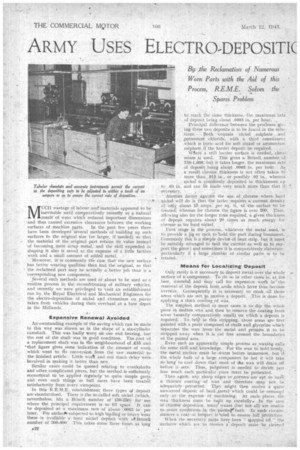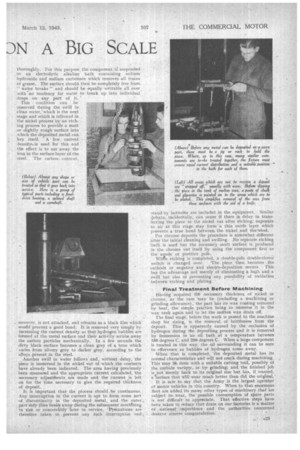ARMY USES ELECTRO-DEPOSITIC
Page 24

Page 25

If you've noticed an error in this article please click here to report it so we can fix it.
DN. A BIG SCALE
By, .the Reclamation of Numerous Worn Parts with the Aid of this Process, R.E.M.E. Solves the Spares Problem
MUCH wastage of labour and' materials appeared to be inevitable until comparatively recently as a natural result of wear which reduced important dimensions — and thus caused .excessive clearances between the working surfaces of machine parts. In the past few years there have been developed several methods of building up such surfaces to the original size (or larger, if needed) so that the material of the original part retains its value instead of becoming mere scrap metal, and the skill expended in shaping it also is saved at the expense of a little further work and a small amount of added metal. .
Moreover, it is commonly the case that the new surface has better wearing qualities than had the original, so that :the reclaimed part may be actually a better job than is a corresponding new component.
• Several such methods are used or about to be used as a _.; routine process in the reconditioning of military vehicles, and recently we were privileged to visit an establishment run by, the Royal Electrical and Mechanical Engineers for the electro-deposition of nickel and chromium on pieces taken from vehicles during their overhaul at a base depot in the Midlands.
Expensive Renewal Avoided
An outstanding example of the saving which cau be made. in this way was shown us in the shape of a six-cylinder camshaft. This was badly worn on one end bearing, but the rest of the shaft was in good condition. The cost of a replacement shaft was in the neighbourhood of £15 and that figure gives some indication of the amount of work ,which went to its conversion from the raw material to the finished article. Little woiii and not much delay were involved in making it better than new,
Similar cases could be quoted relating to crankshafts and other complicated pieces, but the method is sufficiently economical to be applied regularly to quite simple parts. and even such things as ball races have been treated satisfactorily from every viewpoint.
In this R.E.M.E, establishment three types of deposit are standardized. There is the so-called soft nickel (which, nevertheless, has a Brinell number of .150-250) fOr use where the principal requirement is to fill space. It can be deposited at a maximum rate of about .0015 in. per hour. Fer sarfacdh subjected to high loading or heavy wear there is availablea-hard nickel deposit -with all Brinell number of 300-400. :This takes some three times as long
622
to reach the same thickness, .fhe maximum i-ate . of deposit being about .0005 in. per hour. , Principal difference 'between-the proCesses giving these two deposits is to be found in the solu tions. Both 'contain nickel sulphate . and ..potassiumi chloride, with a third constituent which is boric acid for soft nickel or ammonium sulphate if the harder deposit be required. XV-flere a still harder surface is needed, chromium is used. This gives a Brinell, number 750-1,000, but it takes longer, the maximum rate of deposit ,being about .0003 in. per hour. As a result chrome thickness is not often taken to more than ;015 in., or possibly .02 in... whereas nicker is comitionly. deposited in thicknesses up to .03 in. and can be made very much more than that if necessary. • -Andther factor .agaiti-sa the use of ..chrome where hard nickel will do is that the latter .requires acurrent density of onll• about 10 amps. per sq. ft. of the surface 'to be treated, whereas for chrome the figure is over 200. Thus, allowing also for the longer time required, a given thickness or deposit requires about 20 times at much energy for
chrome as for hard nickel. .
First Stage in the process, whatever the metal. used, is. to provide a jig or rack to told the part during treatment Commonly this is a simple device of bent strip, but it must be suitably arranged,tO feed the current as well as to support the piece ; and sometimes it is comparatively elaborate, particularly if a large Mimber of similar parts is to he
• treated. Moans far Localizing Deposit Only rarely is it necessary to deposit metal over the whole surface of a component. To do so in other cases'is, at the best, Wasteful and May call for expensive work in the removal of the deposit from areas which have thus become oversize. Consequently it is necessary to mask all those areas which are not to. receive a deposit. This is done by applying a thick coating of wax.
The simplest method in most cases is to .dip the whole piece in molten wetx and, then tct, remove the coating from areas (usually comparatively small) on which a deposit is required. To helii in this stripping, those areas are first painted with a paste composed of chalk and glycerine which separates the wax fromthe metal and permits it to be stripped away when it is cut free around the boundaries of the pasted area.
Even such an apparently simple process as ,waxing calls for some skill and knowledge. For the wax to hold firmly, the metal surface must be warm before immersion, but if the whole bulk of a large component be hot it will take So long to cool down. that most of the wax will drain off before it sets. Thus, judgment is needed to decide just how much each particular piece must be preheated. Then again, any sharp edges or eorners are apt to has,"6. a thinner coating of wax and therefore may not he adequately protected. They might then receive a quite unwanteddeposit of hard _metal. which could be removed only at the expense of machining. At suchplaces the wax thickness must be billet up carefully. In the case of chrome deposition, many waxes (but not all) are unable to resist conditions in the platinflebath. hi such circumstances a coat -of lacquer is 'uSed to ensure full protection. When the necessary parts have-been " siopped off," the surfaceswhich are to receive a deposit must be cleaned •
thoroughly.. For this purpose the component is` suspended in an electrolytic alkaline bath containing sodium hydroxide and sodium carbonate which removes all traces of grease. The surface should then be completely free from. " water breaks " and should be equally wettable all over with 'no tendency for water to break up into individual drops on any part of it. '
-This condition can be observed during the swill in clean water; which is the next stage and which is followed in the nickel process by an etching process to provide a matt or slightly '1)4h-surface into which the deposited metal can key itself. A low current :lensity.is used for this and the effect is to eat away the iron in the surface layer of the steel. The carbon content.
nowever, is not attacked, and remains as a black film which would prevent a good bond. It is removed very simply by. increasing the current density so that hydrogen bubbles are formed at the metal surface and their actiVity scrubs away the carbon particles mechanically. In a few seconds the dirty black surface becomes a clean grey of a tone which varies from silvery grey to darker grey, according to the alloys present in the steel.
Another swill in water follows and, without delay, the piece is immersed in the nickel vat of which the contents have already been indicated. The area having previously • been measured and the appropriate current calculated, *the necessary adjustments are made and the current is left on for the time necessary to give the required thickness of deposit.
It is important that the process should he continuous. Any interruption in the current is apt to form some sort of discontinuity in the deposited metal, and the outer part ma'y thenbreak away (Turing the subsequent machtning to size or conceivably later in service. Precautions are therefore taken to prevent any Such interruption and stand-by batteries are included in the equipment. Similar qefects, incidentally, can occur if there is delay in transferring the piece, to the nickel vat after etching; exposure to air at this stage may form' a thin oxide layer which prevents a true bond between the nickel and ths 'steel. . For chrome deposits the procedure is somewhat different after the initial cleaning and swilling. No separate etching bath is used but the necessary matt surface is produced in the chrome vat itself by using the component first as the anode or positive pole. When etching is completed, a double-pole double-throw switch is changed over. 'The piece then becomes the cathode or negative and electro-deposition occurs. This has the advantage nol merely of eliminating a bath and a swill but also of preventing any possibility of oxidation ' between etching and plating.
Final Treatment Before Machining Having acquired tilt necessary thickness of nickel or chrome, as the case may be (including a machining or grinding allowance), the part bas its wax coating removed by heat, the simple practice being to immerse it in 'the wax tank again arid to let the molten wax drain off.
The final stage, before the work is passed to the machine sh.op for sizing, is the removal of brittleness from the deposit. This is apparently caused by the occlusion of hydrogen during the depositing process and it is removed by immersion in 'an oil bath at a temperature between 150 degrees C. and 250 degrees C. When a large component is treated in this way, the oil surrounding it can be seen to effervesce as bubbles of hydrogen come away.
When that is completed, the deposited metal has its normal characteristics and will not crack during machining. This may be done with a suitable cutting tool, possibly of the carbide varisty, or by• grinding; and the finished job is not merely back to its original size but has, if wanted, a liurface that will wear much better than did the original.
It is safe to say that the Army is the largest 'operator of motor vehicles in this. country. When to that enormous fleet are added its maRy other types of machinery that are subject to wear, the possible consumption of spare parts is not difficult to appreciate. That effective steps have -been taken to reduce that drain on our factories is a matter of :national irripotibnce and the authorities concerned deserve sincere congratulation.




























































